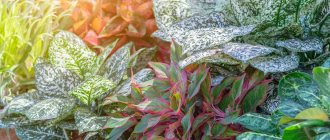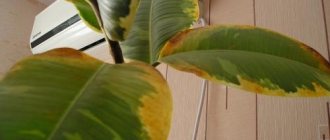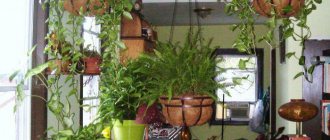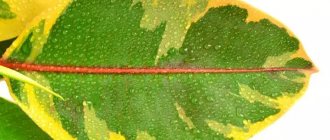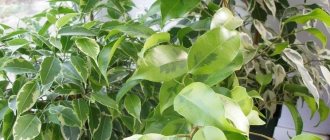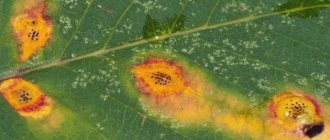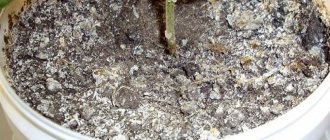Aglaonemas, difficult or not? Despite the fact that aglaonema is generally a rather unpretentious indoor plant that is ready to delight its owners with its lush bush all year round, from time to time we all encounter various pains and sorrows. We talk about the most common problems with aglaonema.
Why do Aglaonema leaves turn yellow?
The variety of colors of aglaonema leaves is amazing.
Yellowing of leaves is the most common problem with aglaonema. It is typical for any species - both with green leaves and colored ones.
Natural growth and aging Yellowing and dying of old lower leaves is a natural process: this is how the plant rejuvenates and continues to grow.
Bay However, if yellow leaves appear too quickly one after another, and the plant loses its decorative appearance, then most likely the reason is the flood. We told you how to water aglaonema - try to follow these instructions.
To stop the process of yellowing of leaves, dry the earthen ball. Drying in the pot will be sufficient if the soil is moderately moist and the temperature of the room where the aglaonema grows is not lower than +22. Just stop watering for a week or two - be guided by the condition of the soil.
If the room is cool, then it is better not to leave the alaonema in a wet pot. Remove the plant along with the earthen lump and let it dry outside the pot. At the same time, check the condition of the roots - due to high humidity, rot easily develops. Remove rotten roots. It is optimal to sprinkle the sections with a fungicide - an excellent option is phytosporin. You can lightly dust the entire root system with it before planting for prevention. After the earthen ball has dried sufficiently, you can put the aglaonema back into the pot. If the soil is very wet and does not dry out (for example, poorly aerated, heavy), take the opportunity to replace it. Carefully remove the remnants of the old soil from the roots and replant them into new soil.
Adaptation after moving, rearranging, purchasing If yellow and dry leaves appeared after acquiring aglaonema / moving the plant to a new place, then the matter may be a shock due to the move, which is common for many plants. Provide the aglaonema with the necessary conditions for light, temperature and watering, cut off the leaves that have lost their decorative effect and wait for the flower to adapt to the new conditions. You can help aglaonema a little by treating it with any adaptogen.
2. Propagation of indoor plants
Throughout its life, the plant produces lateral shoots and basal suckers , which are used for vegetative propagation in spring or summer.
- Cuttings of aglaonema are best done in a special heated container, in vermiculite.
- Often cuttings take root even in a simple glass of water. You can even plant stems that have taken root and do not have leaves - they will begin to grow from the awakened lateral buds and will produce additional shoots from the buds that are located underground.
- Such stem cuttings should be placed horizontally, lightly sprinkled with moist soil - this will make the plant more lush, because leaves and roots will appear in each dormant bud.
- The successful completion of the rooting process will be indicated by the appearance of signs of new growth - young shoots.
Many varieties of Aglaonema are propagated by seeds and air layering . Seeds germinate in 25 - 30 days. For propagation, only freshly collected seeds are used.
Large adult specimens are propagated by division , which is carried out in the spring, during transplantation. The bushes are divided in such a way that each part ultimately receives its own, well-developed root system and green ground part.
↑ Up,
Why do aglaonema leaves become soft and brown?
Composition of different varieties of aglaonema
If the leaf first turns yellow, then turns brown, then see the recommendations for baying above.
Hypothermia If the leaf completely limp and then turns brown and rots, and you are sure that there was no flooding, the cause may be hypothermia - for example, due to an open window in winter during ventilation.
Aglaonema stems are very succulent, and if exposed to extreme cooling, the water in them can freeze. When water crystals freeze, they expand and can damage cells with their sharp edges. Of course, with short ventilation it is difficult to achieve complete freezing of the plant, but some leaves and parts of the stem may well be damaged. Therefore, do not allow aglaonema to overcool - unlike some other indoor plants, it does not tolerate even short-term cold.
6. Transplantation of aglaonema
Replant as necessary - about once every three years , since the plant grows rather slowly.
Don't use a pot that's too big—aglaonema grows best when its root system is cramped .
Try not to disturb the root system again and use transshipment along with a lump of earth.
When transplanted, adult plants that form a trunk are placed horizontally - at the same time, dormant buds wake up on the stem and each of them forms its own leaves. As a result of this procedure, you can get a chic, lush plant.
Planting in fresh soil is carried out in the spring , when the plant wakes up and demonstrates its readiness to develop.
↑ Up,
Why do Aglaonema leaves droop?
Aglaonema with green leaves
There are two main reasons for drooping leaves: inappropriate lighting and underwatering. But, as always with plants, options are possible.
Too much light If the light is too bright, the plant will curl its leaves and droop them to reduce the leaf area exposed to sunlight, protecting itself from sunburn. If aglaonema grows on your south-facing window, this is possible on hot sunny days. But in general, this is not the most typical reason for keeping aglaonema at home. The treatment in this case is simple: remove the plant from direct light.
Too little light Leaves may droop even in low light conditions. If aglaonema is on a window, in middle latitudes this is an unlikely cause even in winter, but in more northern latitudes it is quite possible. With a lack of light, the process of photosynthesis slows down, which means that the plant receives few nutrients, it does not have enough nutrition to feel cheerful and proudly carry all its leaves.
To help the plant, move it to a more illuminated area or organize lighting - you can use both phytolamps and ordinary spotlights with white light.
Flooding If drooping leaves are accompanied by yellowing and dried out tips, check the watering regime: most likely, you have flooded the plant.
We described what to do in this case above in the paragraph “Why do the leaves of Aglaonema turn yellow.”
Underwatering Very often the reason for drooping leaves lies in underwatering. In this case, drooping leaves can also turn yellow and dry out the tips, but unlike overflow, the leaves will not just be limp, but rather brittle and dry. And, of course, the condition of the soil should tell you with all certainty whether it is overwatering or underwatering.
Water the dried aglaonema by immersing the pot in water. Let the soil soak in moisture for a few minutes. Then allow excess water to drain from the pot through the drainage holes and place the plant in place. It is advisable not to carry out such manipulations during the cold season - in winter, begin to gradually “water” the plant with small doses of water.
Briefly about cultivation
- Flowering: grown indoors as an ornamental foliage plant.
- Lighting: Green-leaved varieties need partial shade, while variegated varieties need bright, diffused light with protection from direct sunlight.
- Temperature: during the growing season – 20-25 ºC, in winter – not lower than 16 ºC.
- Watering: in spring and summer - plentiful, as soon as the top layer of soil dries, in winter watering is reduced: the substrate is moistened when two days have passed after the top layer of soil has dried.
- Humidity: high. The plant requires regular spraying in the warm season. In winter, the plant should be kept on a tray with wet pebbles.
- Feeding: during the growing season - twice a month with mineral and organic fertilizers in turn. In winter, the plant is not fed.
- Dormant period: from September to February.
- Transplantation: young plants are replanted annually, adults - once every 4-5 years. Transplantation is carried out in the spring, before active growth begins.
- Substrate: three parts of leaf soil, one part of peat and sand, and half of charcoal and humus soil.
- Reproduction: cuttings, dividing the bush and seeds.
- Pests: spider mites, whiteflies, aphids, thrips, scale insects and mealybugs.
- Diseases: root rot, gray mold and rust.
- Properties: the plant is poisonous.
Read more about growing aglaonema below.
Why do Aglaonema leaves dry out?
Aglaonema loves humidity, but it is better to use a humidifier rather than a spray bottle.
A more advanced case of yellowing of leaves. When we see brown, dried leaves, the very first thought that arises is that the plant lacks moisture. But in the vast majority of cases this is not the case at all.
Overwatering If the tips of the leaves dry out, the most common cause is overwatering. Make sure the soil in the pot dries out sufficiently between waterings, and adjust the watering schedule if necessary. Aglaonema reacts in a similar way to drafts and temperature changes.
Natural aging process If the entire lower leaves of a plant dry out - first they turn yellow, then gradually turn brown and fall off - this is a natural process. If the leaves do not dry out en masse, then there is nothing to worry about.
Too little light If the lower leaves dry out en masse, and the plant begins to lose its decorative appearance, stretches out, and the trunk becomes bare, then with a high degree of probability it can be assumed that it does not like the growing conditions, first of all, the lighting.
When there is insufficient lighting, aglaonema tries to reach the light, so it grows upward. Because There is not enough light and photosynthesis slows down, the plant gets rid of “extra” lower leaves, which lack light the most. Therefore, the best treatment in this case would be to provide the aglasha with sufficient illumination.
If the plant has already become quite elongated, it is better to re-root it, because a bald trunk will not grow leaves again. We describe in detail how to re-root an aglaonema with an elongated stem in the article on the propagation of aglaonema.
Burn If the upper young leaves dry out, especially if the dried areas are scattered in large spots on the surface of the leaf, sunburn is very possible - especially in variegated species with light colors - pink, white, golden, light green. It is the upper leaves that receive the highest dose of solar radiation, and therefore are more susceptible to burns than others. Adjust the lighting - move the aglaonema a little further from the light source (windows, lamps) or shade it with tulle.
Kinds
Aglaonema shiny / Aglaonema nitidum
The homeland of the species is damp forests on the plains of Sumatra, Thailand, Kalimantan and Malaysia. The trunk reaches 1 m in height. Dark and bright green leaves grow up to 45 cm in length, up to 20 in width, and have an oblong shape; the upper side of the leaf is glossy. Flowers are collected in inflorescences of two to five pieces. The six-centimeter cob is covered with a blanket of almost the same length. The fruits grow white.
- Dracaena domestica - how to care
Aglaonema commutatum
Another name is Aglaonema variable. The species is native to Sulawesi and the Philippines. The stem is straight, 20-150 cm long. The leaves grow on long petioles; The leaf length is up to 30 cm, and the width is up to 10 cm. The flowers are collected in inflorescences of three to six flowers. The thin six-centimeter cob is covered with a longer pale green blanket. Red berries are the fruit and increase the decorative value of this type of aglaonema.
warburgii variety has white stripes along the lateral veins of the leaf. elegans variety is distinguished by elongated oval leaves of a light green color with a pale green pattern on them. maculatum variety has leaves that are elongated oval in shape and dark green in color with white strokes on the leaf blade.
Aglaonema oblong-leaved / Aglaonema marantifolium
The species is native to the tropical rainforests of the islands of Penang and Borneo, as well as the Philippines and Singapore. Large dark green leaves grow up to 30 cm and are attached to twenty-centimeter petioles. The leaves of some varieties of Aglaonema oblongata are covered with a silver-gray pattern.
Painted Aglaonema / Aglaonema pictum
Aglaonema lives in humid forests on the island. Borneo and about. Sumatra. The trunk branches and grows up to 60 cm in height. The leaves are large, dark green in color and elongated-elliptical in shape, unevenly covered with gray spots. Some varieties of this species have white-silver spots. The fruits grow red.
Aglaonema ribbed / Aglaonema costatum
It lives in the rainforests of the tropical part of South-West Malaysia. Herbaceous plants. The trunk branches at the base. The leaves grow up to 20 cm in length and up to 10 cm in width. The leaves are dense, green in color with white streaks and spots.
Aglaonema modestum / Aglaonema modestum
Another name is moderate aglaonema . The homeland of this species is moist forests on the mountain slopes of the tropical part of the Malay Archipelago and Indochina. Aglaonema grows up to half a meter in height, the trunk branches. Leaves up to 20 cm long and up to 9 cm wide; have an oval shape, a sharp apex, a blunt base, and a green color; there are several prominent lateral veins on each side of the midrib. The fruit is similar to the dogwood fruit, red in color.
Why were the leaves of Aglaonema crushed?
Aglaonema Maria
The main reason is lack of nutrition. The plant receives nutrition from 1) soil and 2) through the process of photosynthesis.
Based on this, we solve the problem: check the soil - perhaps you haven’t replanted the plant for a long time and the soil is depleted? If replanting is not required and the soil looks good, feed the aglasha with a balanced mineral fertilizer (equal shares of nitrogen, phosphorus, potassium, or an emphasis on nitrogen).
Lack of light and slower photosynthesis can also cause leaf shredding. Move the plant closer to the light.
A common reason is that aglaonema has spent all its energy on flowering. Support the plant with fertilizing and provide optimal conditions for light and temperature. The recovery process may take several months.
Lighting and air temperature
A pot with a plant cannot be placed on a windowsill that is located on the sunny side. Bright, hot rays can cause leaf burns. Therefore, it is better to choose partial shade. It is also important to consider the type of flower. For example, those species whose leaves are brightly colored should be installed in places with bright but diffused light.
In the winter season, additional lighting of Aglaonema should be provided. The total duration of the plant's exposure to light is at least 15 hours.
The flower should be protected from drafts and exposure to tobacco smoke. The ideal place for Aglaonema is a well-ventilated room, but not the kitchen.
In summer, the optimal temperature range is from 20 to 25 degrees. Lower values are suitable for winter. The air must be moist. The figure is 50-60%. If the leaves of the plant dry out, it means it is standing too close to the heating devices. A large pan filled with water will help reduce their negative impact.
How to make aglaonema bush?
New shoots of aglaonema
In good light, aglaonema bushes on its own quite willingly, often produces babies, and this process does not require additional intervention.
However, if you think the plant needs help forming a thick head of leaves, carefully remove the last two young leaves from the center of the rosette. Firmly grasp the leaves where they emerge from the central rosette and gently pull them upward. The leaves should come out whole, without breaking off. In this case, the plant will use its strength to increase the size of existing leaves and produce children, which will add splendor to the bush. There is no need to cut off the top leaves with scissors. In this case, most likely, the growing point will not be lost, and the plant will continue to produce new leaves from the central rosette.
Diseases and pests
Aglaonema is susceptible to fungal diseases. They appear as brown or gray plaques on the leaves or petioles at the roots. In this case, the damaged areas are cut back to healthy tissue and then treated with fungicides. A good prevention of rot is proper watering for drainage.
The succulent leaves of even indoor aglaonema are attacked by aphids, thrips and mites. Most parasites are so small that they are invisible without a magnifying glass. If dry spots or tiny punctures appear on the leaves, you should spray the bush with an insecticide.
Aglaonema has bloomed - what to do?
Blooming aglaonema
Like many aroids, aglaonema flowers are not highly decorative, although we personally like them - delicate, white, they greatly decorate the plant. However, very often the plant spends too much energy on flowering and after it greatly loses its decorative effect: the leaves turn yellow and dry out, the bush thins out, new leaves are formed small.
Ideally, to preserve the decorative appearance of aglaonema, it is worth cutting off its flower stalks. As a rule, if a plant is well fed with nitrogen fertilizers, it bushes happily, grows green mass and doesn’t think much about flowering. Therefore, do not forget to fertilize the aglasha properly so that it cares about its lush leaves and not about flowering.
If you decide to leave the flower stalks - and here we really understand you! – support the plant with a complex fertilizer with a high content of phosphorus and potassium (for example, NPK 8:20:26), and immediately after flowering, again focus on nitrogen-containing mineral fertilizers (fertilizers with equal contents of nitrogen, phosphorus and potassium are also suitable - for example, NPK 17 :17:17).
Growing, step-by-step care
Although aglaonema comes from tropical forests, as a houseplant it grows well under a number of conditions. Growing aglaonema is not difficult; even a novice gardener can cope with it. The main thing that aglaonema needs is diffused light. If you put it in full sun, it will die.
Watering, spraying
The origin of the plant affects its moisture requirements. High humidity is necessary for both the substrate and the air.
The only difficulty in growing aglaonema is proper watering and ensuring proper air humidity.
In summer, when it’s warm, you need to water the aglaonema even daily! You need to remember to spray the plant, this species loves water. A mixture of varieties in a pot is also watered frequently. In winter, the plant enters a state of partial dormancy, its development slows down, so water it once a week.
For watering and spraying, only soft water is used so that ugly spots do not form on the beautiful leaves of the plant. How to get soft water? It is enough to boil water in a kettle. After watering, you need to wait 15 minutes and drain the water remaining on the stand. Aglaonema does not like soaking; excess water harms its roots.
The real enemy of aglaonema is the dry air that occurs in apartments in winter.
The plant really doesn’t like this, which is manifested by the drying of the tips of the leaves. When the heating season begins, you need to take extra care of the plant by placing a humidifier next to it and frequently spraying it with water mist at room temperature. You can place the pot in a high stand, filled to the brim with expanded clay, and pour water into it, which, as it evaporates, will deliver moisture.
Only in winter should watering be limited, without leading to drying out of the substrate, and the plant should be sprayed only when the air in the apartment is very dry.
Fertilizer
Aglaonema is fertilized regularly from March to September. Universal preparations should be used for plants with decorative leaves. These are preparations containing potassium and phosphorus, without calcium. Liquid fertilizers are used every 2 weeks, sticks or gel fertilizers - in accordance with the manufacturer's recommendations.
Attention! Due to soil preferences, you cannot feed aglaonema with fertilizers rich in calcium, which increase the soil pH.
Nutrient deficiencies can cause leaves to turn yellow or pale. Aglaonema sometimes drops its lower leaves - this is completely normal. If this does not happen suddenly and the aglaonema does not go bald, then everything is fine. If this happens suddenly, it is worth inspecting the roots or paying attention to whether there are any traces of insects. The most common culprits are scale insects or scale insects.
In autumn and winter, aglaonema does not experience deep dormancy, but its development slows down, so you should stop fertilizing the plant until spring.
Reproduction
The simplest and fastest ways to propagate aglaonema:
- from pieces of stems;
- apical cuttings;
- from seeds.
Aglaonema can be propagated in the spring, when it resumes intensive vegetation. Young plants are initially replanted every year, and old plants are replanted every 2-3 years. When transplanting, the plant can be propagated by dividing grown specimens, as well as by root cuttings or cuttings of the main shoot (they take root in a moist peat substrate, but this takes quite a lot of time).
Seedlings and seeds are planted in an appropriate substrate and provide the plant with a temperature of 22-24 °C.
Trimming
Plants that are too bulky can be pruned in the spring, using the cut tops as seedlings. This is also a good way to make your aglaonema bushier. Trimmed apical cuttings can be rooted and planted separately. The pruned plant does not look very good at first, but after a short time it will begin to produce lateral growths on the stem, acquiring a very interesting appearance.
It is worth observing the leaves; if the leaf blade begins to turn yellow or wither, without regret we remove it with a sterile instrument.
Experienced gardeners trim off aglaonema inflorescences because they are not very attractive and can weaken the plant.
Pests and diseases
Aglaonemas are naturally quite healthy plants and are not very susceptible to pest attacks, but improper care can lead to:
- the appearance of symptoms of a fungal disease (for example, leaf spot);
- physiological disease (root rot caused by excessive substrate moisture or drying out of leaf tips as a result of too dry air).
Sometimes aglaonema is affected by pests such as spider mites (if the air in the apartment is too dry).
Why do the leaves turn yellow and fall off?
Sometimes novice gardeners notice alarming symptoms and ask why aglaonema leaves turn yellow. The reasons may be the following:
- Insufficient air humidity can cause leaves to sag or dry out; you need to remember to humidify the air and spray the plant.
- Insufficient air temperature causes deterioration in the health of aglaonema. This tropical plant loves stable heat. Aglaonema sheds its leaves in too cool a room or in a draft.
- Too compacted soil does not allow nutrients to pass through. In this case, it is necessary to replant the plant.
- Chlorosis. Excessive yellowing of aglaonema leaves is often caused by the development of chlorosis. This occurs when the soil pH is too high or when overwatered.
- Pests. Aglaonema can become a victim of mealybugs. Signs of their presence are a characteristic bloom, yellowing, and falling leaves.
- Lack of nutrients and insufficient light cause poor leaf coloration. The problem can be prevented by feeding the bushes with appropriate preparations intended for green plants and choosing a more illuminated place.
If the plant is properly cared for, it can become an excellent home decoration. It initially takes the form of a bunch of leaves and looks best when planted alone in a pot. When the stem begins to grow upward, shedding leaves from below, you can plant other species nearby that will act as ground cover (for example, climbing ficus). Aglaonema is also an ideal plant to grow hydroponically.
Is Aglaonema a poisonous plant?
Aglaonema with green leaves
Let's put this point in a separate paragraph, because the toxicity of aglaonema can pose a problem for gardeners with small children and animals.
Like many other aroids, for example, the beloved Dieffenbachia, Aglaonema is potentially poisonous to humans, because The plant juice contains calcium oxalate. If it comes into contact with the skin and mucous membranes (mouth, nose), the juice MAY cause irritation (but does not necessarily cause it!). If it enters the gastrointestinal tract, the juice causes irritation, burning and swelling. Accordingly, the plant is inedible - it is better to keep it out of the reach of small children.
The same applies to pets – cats and dogs in particular. If the animal has chewed and especially swallowed the leaf, you will have to show it to a veterinarian and arrange for a gastric lavage.
Top dressing
Caring for the plant involves not only regular watering, but also fertilizing. Mineral fertilizers are applied twice a month. These substances must necessarily contain nitrogen, potassium, phosphorus, and microelements.
In order to positively influence the development and decorative appearance, it is recommended to carry out foliar feeding. To do this, the leaves are sprayed with light nutritional compounds. This is done the next day after watering.
After the procedure, it is important to ensure that the flower is not exposed to direct sunlight. If the weather is not cloudy, it is better to postpone spraying and carry it out in the evening. This will prevent burns on the leaves.
During the growing season, which lasts from March to August, the plant is fed every two weeks. In this case, be sure to alternate organic and mineral fertilizers. By autumn, aglaonema begins to reduce its growth rate, so substances should be added less frequently. And in winter, during the dormant period, there is no need for fertilizing.
Aglaonema in the house
Family: Araceae (Fam. Araceae)
An attractive, unpretentious indoor flower that has large, shiny, leathery leaves that are always green in color with marbled speckles of cream and gray on short stems. It is no coincidence that the name of this flower comes from the Greek aglaia meaning “brilliance”. Aglaonemas can be grown hydroponically, but they must grow in water from the very beginning.
Most Aglaonema species are native to southern Asia, some from Malaysia, others from India and China. Their natural habitat is very diverse: there are typically terrestrial plants, they are also found in the coastal zone, and sometimes they grow on trees.
Aglaonemas grow quite slowly, do not like smoke and drafts, refresh and purify the air and release substances that kill microbes.
Selection and purchase
Choose young plants without yellowed leaves with firm, erect leaves.
Content
- Types of Aglaonema
- Aglaonema care
- Problems of growing aglaonema
- Aglaonema pests
Aglaonema is a relative of Dieffenbachia and therefore somewhat similar to it, differing in narrower leaves and size (Aglaonema is much smaller than Dieffenbachia, and the plant itself has the shape of a bush, a week-old tree). In addition, aglaonemas bloom for quite a long time and form fruits. This is one of the most suitable plants for hydroponic culture.
The classification and taxonomy of Aglaonemas has undergone major changes in recent years. In fact, experts have shuffled the Aglaonema genus like a deck of cards; the latest data in the databases of famous botanical gardens is dated 2012; many of the species, variations and forms are still under debate.
Planting and care at home
The aglaonema flower, shown in the photo below, naturally grows in shady places. Therefore, when grown indoors, it is placed in partial shade. Exposure to direct sunlight on leaf plates can result in sunburn. When growing varieties with variegated leaves, they are provided with bright, diffused lighting so that they do not lose their decorative appearance.
The length of daylight for a tropical flower should be from 11 to 15 hours. A lack of lighting provokes lengthening of internodes, shrinking of foliage and loss of decorativeness. Such a plant absorbs moisture and nutrients worse.
Temperature
It is easier to care for a home flower at room temperature from +20°C to +25°C. In winter, the plant is left in a room where the air warms up to no less than +15°C. For a short time, aglaonema can withstand cold temperatures down to +10°C. A tropical plant does not require rest in winter, but it is necessary for the beauty of the leaves. The plant does not tolerate sudden changes in temperature. Also, his condition worsens if the temperature rises above +26°C.
Watering
To water a tropical plant, use only soft water. The bush is moistened immediately after the top layer has dried. Regular irrigation is especially needed in spring and summer, when there is a period of active growth. Too much water in the soil, as well as a lack of moisture, are harmful to the plant. In the winter months, the frequency of watering is reduced. Re-wetting is carried out three days after the surface layer of soil has dried.
Air humidity
Aglaonema requires high humidity. When the air is very dry, the growth rate of leaves slows down. The ends and edges of the leaf plates dry out. To maintain normal humidity, the bush is regularly sprayed with warm water from a fine spray bottle. Additionally, the pot is placed on a tray with wet stones so that the bottom of the container does not come into contact with water. Otherwise, the root system begins to rot.
Proper watering of an orchid during flowering
In winter, tropical flowers are sprayed only in rooms with constantly running heating devices, if the temperature does not drop below +16°C. In cool winter conditions, plants standing on wet stones do not need additional spraying.
Feeding
Aglaonema needs additional nutrients only during the active growth stage in the spring and summer. For tropical plants, preparations containing nitrogen and potassium are suitable. Mineral complexes alternate with organic matter. Fertilizing is carried out twice a month, diluting the preparations in water in accordance with the attached instructions.
Important! Nutrients are added after the soil is moistened. For aglaonema, in addition to root feeding, foliar spraying is necessary
Spraying with fertilizer solutions is carried out in the morning or evening, when there is no bright sunlight.
Transfer
For the first time, a tropical flower is replanted 7 days after purchase, since store-bought soil is not suitable for permanent cultivation. For young specimens, replanting is needed every year in the spring before flowering begins. Grown bushes are moved to a new container no more than once every 4 years, when the root system completely envelops the earthen ball. The new container is chosen so that its diameter exceeds the size of the previous pot by 2-3 cm. Boxes with drainage holes at the bottom, small in volume, are suitable so that the plant spends energy on developing the above-ground part of the bush, and not on root formation.
Aglaonema requires loose soil with high acidity. The soil is mixed from the following components:
- 2 parts river sand;
- 1 part of turf land;
- 6 parts leaf soil;
- 2 parts charcoal;
- 2 parts peat.
At the bottom of the selected container, drainage is placed from broken bricks, expanded clay or pebbles at a quarter height. Then the prepared soil is poured halfway. The flower is removed from the old container and the roots are cleared of the soil. By placing it in the center, straighten the root system. The remaining space is filled with soil up to the root collar. The soil is compacted and well moistened.
Home care and maintenance
Tropical plants always need high humidity and constant warmth without drafts and direct hot rays of the sun.
Proper care will not only help protect your indoor plant, but also make it more attractive. Lighting. For plants with green leaves, the issue of lighting is not important, since they grow everywhere. Variegated plants have a craving for bright and diffused light. Direct sunlight can cause burns on the leaves.
Temperature. In winter, the room temperature should always exceed +16°C, and there can be no talk of drafts at all. The optimal temperature for growth is around 20-25°C. Even the rarest changes in temperature have a detrimental effect on the life of the plant.
Air humidity. A tropical flower requires high air humidity. In summer, it is recommended to spray it every day, as well as monitor the accumulation of dust on the leaves and clean them regularly. Do not cover the leaves with a special chemical solution for shine, as this is very harmful to the plant.
Watering. With natural growth, aglaonema receives abundant watering daily, as it grows in tropical forests and near rivers. For the growing season, there is a main condition - the houseplant should be watered abundantly. In autumn and winter, watering must be reduced. Do not allow the earthen ball to dry out, which can be dangerous for the plant. Be careful not to overwater the plant in cool weather.
Fertilizer. During the active growth phase, additional attention is required. It must be fed several times a month with a special mineral fertilizer in liquid form. But you should not feed the plant in winter, as this can only cause harm.
Transfer. Aglaonema grows very slowly. In the spring, it is recommended to replant young plants every year, and in subsequent years, do this not so often - once every 3-5 years. This is a tropical plant that produces excellent leaf growth when the roots are confined to a small container. Make sure there is always decent drainage.
The soil. It is always recommended to use only light and loose soil that will drain water perfectly. The ideal mixture must necessarily include leaf soil, peat and sand in a 2:1:1 ratio. Quite often crushed charcoal is added. You can use a different soil composition - peat, leaf soil, light turf soil and an increased dose of sand. Growth is noticeably accelerated in hydroponics.
Reproduction. Due to its slow growth, the plant is very heavy and difficult to propagate. This process can be carried out in several ways - by seeds, cuttings, and also by separating daughter plants. The easiest way to divide the bush is during replanting, when you can separate already rooted shoots with a few new leaves. It is better to take cuttings in the summer, when it is relatively warm. Sowing seeds is usually done by real enthusiasts, as this is a rather complex and sensitive process.
Diseases and pests
Recently, aglaonema has been increasingly attacked by common pests - thrips, scale insects and aphids. In hot weather and dry air, you should be wary of red spider mites. It is worth constantly inspecting the plant and not missing any emerging pests. And then you will be able to get rid of them in simple ways without the use of chemicals. Fungal diseases include gray rot and unusual leaf spotting. You can fight them with fungicidal drugs.
Description of Aglaonema chinensis
The decorative foliage plant is distinguished by fleshy, short, erect stems, patterned leathery and dense leaves on short or long petioles and an inflorescence in the form of a light green spathe and a white cob.
Among gardeners, the indoor plant aglaonema is valued for its beautiful foliage, which, depending on the variety, can have different patterns, sizes and colors. In the middle of the ovate or lanceolate leaves there is a depressed vein, which is convex at the bottom of the leaf blade.
Aglaonema flowering has no decorative value, so it is recommended to remove the spadix and spathe. Otherwise, all the plant’s energy will be spent on flowering, and new and beautiful leaves will not appear. If you leave the inflorescence and let it bloom, then after about six months it will ripen fruits in the form of juicy berries, each of which contains one orange or white seed.
Propagation of Aglaonema by cuttings
The plant reproduces throughout the growing season. It must be healthy and tall. Most often, propagation is carried out by root suckers, division of the mother plant, seeds and stem cuttings. We will talk about the last type of reproduction.
So, propagation of aglaonema by cuttings is considered a labor-intensive and time-consuming process.
First, the upper part of the shoot is cut off from the stem. When cut, the plant is treated with charcoal. You can also use activated carbon (2-3 tablets). In pre-prepared, moistened peat and sand mixed in equal proportions, a cutting with two buds is planted to a depth of 4-5 cm.
It is better to root aglaonema in small greenhouses with fertile soil. Therefore, at home, the container where the sprout is located is covered with cellophane or a transparent cap. At room temperature, adventitious roots will be formed after 30 days.
After the cuttings have taken root, they are planted in small pots or in different flowerpots separately.
Cuttings are best done in spring and summer. When placing flowerpots with young seedlings on window sills, it is better to choose the northeast or northwest.
